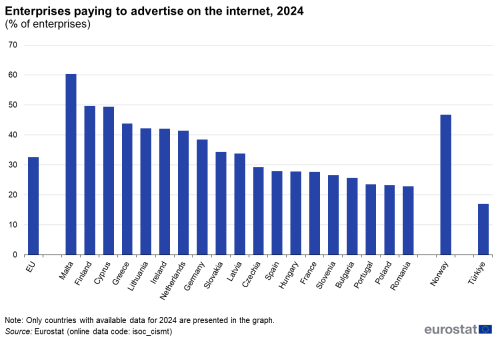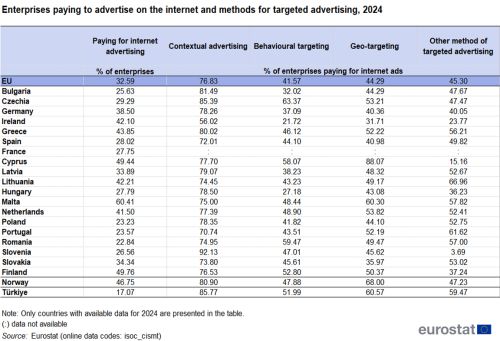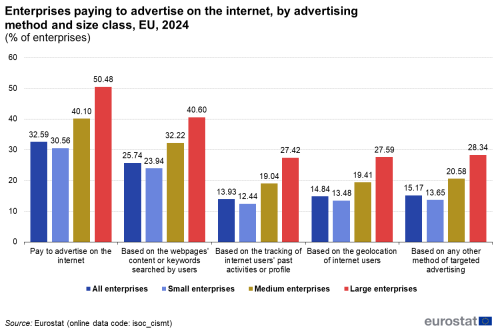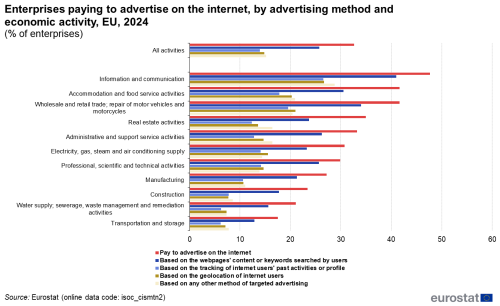Data from April 2025
Planned update: April 2026
Highlights
In 2024, almost 1 in 3 EU enterprises (32.59%) advertised on the internet.
In 2024, contextual advertising was the favourite form of internet advertising.
Enterprises paying to advertise on the internet, 2024
The internet has become an essential component of communication across the globe between marketers, advertisers and customers. More specifically, websites have become customers’ first port of call for seeking information and eventually purchasing goods or services, whether online or offline. Consequently, enterprises are increasing their presence on the internet and improving their advertising practices so that current and prospective customers receive ads with content that is relevant and meaningful to them. This article presents recent statistics on businesses using paid internet advertising in the European Union (EU).
General overview
- Nearly 1 out of 3 (32.59 %) enterprises in the EU used paid internet advertising in 2024.
- The most popular form of targeted internet advertising used by EU enterprises was to use information from the content of the webpages viewed by internet users (contextual advertising).
- Nearly half of EU enterprises (47.70 %) in information and communication paid for internet ads in 2024.
Ads that reach the right audience with relevant and meaningful content
In an effort to maximise profits and the effectiveness of their ads, businesses constantly develop innovative advertising practices, embracing the most advanced digital technologies available. As can be expected, companies run their marketing campaigns on the internet and use targeted advertisement methods that increase the likelihood of their promotional marketing messages reaching the right audience.
For this purpose, enterprises use technologies embedded in websites and apps that choose ads based on the content of the webpages internet surfers view. This is commonly known as online contextual advertising. Internet users are presented with adverts that automated systems (ad servers) have selected for them based on the content of the webpage they are browsing. Similarly, contextual advertising can be based on the specific keywords used in the user's latest internet query. In this way there is always a positive correlation between internet ads and the user's interests, based on either the content of the webpages or keywords from queries.
In addition to contextual advertising, enterprises may use behavioural targeting. This, another targeted form of internet advertising, is based on information about a user's past browsing activities recorded by cookies. The digital trace of a user's activities on the internet over time is an important source of information on their interests, preferences and shopping activities. Businesses may use this information to determine whether an internet user belongs to a specific target audience, subsequently sending internet ads matching the user’s profile.
Browsers for accessing the internet provide geolocation services, essentially attempting to locate a user's IP address, Wi-Fi or network location. An internet user's geographic location such as the country, region, city and often zip code provide useful information for targeting suitable advertisements, for example about restaurants nearby. The use of geo-targeting advertising can be combined with using contextual advertising or behavioural targeting in order to further identify the needs of a potential customer.
Information on the use of the remaining targeted advertising practices, not covered by the dynamic ones mentioned above, was collected in a single category. It concerned the use of static internet ads on:
- subject-specific websites (e.g. displaying ads on spare parts for car engines on websites about vehicles or with automotive themes); or
- websites such as online newspapers, magazines or blogs for a specific audience.
Use of internet ads by enterprises
In the last 2 decades, the internet has redefined traditional broadcast media — television and radio — as well as print media, such as magazines and newspapers. It offers a number of new or extended services, particularly in marketing and advertising. In 2024, some 32.59% of EU enterprises with at least 10 employees and self-employed persons reported paying to advertise on the internet. Among the EU countries, internet advertising was used by more than 3 in 5 enterprises in Malta (60.41%), and by nearly half of enterprises in Finland (49.76%) and Cyprus (49.44%), while it concerned less than 25% of enterprises in Romania (22.84%), Poland (23.23%) and Portugal (23.57%), see Figure 1.

(% of enterprises)
Source: Eurostat (isoc_cismt)
The use of contextual advertising was far more popular than the other types of targeted internet advertising. This is most likely because the technologies embedded into webpages are easy to implement. Some 76.83% of EU enterprises that paid to advertise on the internet, used information from the content of internet surfers’ webpages or keywords from their queries to identify the audience accurately before sending relevant ads. In 4 EU countries this type of advertising was used by more than 80% of enterprises that have paid for internet ads in 2024, with the highest share recorded in Slovenia (92.13%).
Behavioural targeting was used by 41.57% of EU enterprises paying for internet advertising, while geo-targeting was used by 44.29%. Some 45.30% of enterprises using internet ads reported using targeted internet advertising methods other than those mentioned above. For behavioural targeting, the highest shares were recorded in Czechia (63.37%), Romania (59.47%), Cyprus (58.07%) and Finland (52.80%). Geo-targeting was used most by enterprises advertising online in Cyprus (88.07%) followed by Malta (60.30%), the Netherlands (53.82%) and Czechia (53.21%) (Table 1).

Source: Eurostat (isoc_cismt)
As presented in Figure 2, the distribution of the types of online advertising methods used did not differ much between enterprises of different size classes. Contextual advertising was the most popular type of internet advertising regardless of the enterprise size class and was used by 40.60% of large, 32.22% of medium and 23.94% of small enterprises. Paid internet advertising based on the geolocation of users (geo-targeting) was the second most widely used type with 27.59% of large, 19.41% of medium and 13.48% of small enterprises reportin having used it in 2024.

(% of enterprises)
Source: Eurostat (isoc_cismt)
As Figure 3 shows, in 2024 more than 40% of enterprises paid to advertise on the internet in information and communication (47.70%), in accommodation and food service activities (41.63%) and in wholesale and retail trade (41.62%). In these 3 economic sectors, contextual advertising and geo-targeting were the most popular types of internet advertising used by more than 20% of enterprises. Behavioural targeting was used most by enterprises in information and communication with more than a quarter of enterprises (26.51%) reporting having paid for that method of internet advertising in 2024.

(% of enterprises)
Source: Eurostat (isoc_cismtn2)
Source data for tables and graphs
Data sources
Source: Data presented in this article are based on the results of the 2024 survey on 'ICT usage and e-commerce in enterprises'. Statistics were obtained from the surveys conducted by National Statistical Authorities in the first months of 2024. The questions on paid internet advertising and on targeted advertising methods were both included as optional in the 2024 survey on 'ICT usage and e-commerce in enterprises and therefore data are not available for all EU Member States and candidate countries.
Sample: In 2024, 157 000 of the 1.54 million enterprises in the EU were surveyed. Of the 1.54 million enterprises, approximately 83 % were small enterprises, 14 % medium and 3 % large enterprises.
Main concepts: The observation statistical unit is the enterprise, as defined in the Regulation (EC) No 696/1993 of 15 March 1993. The survey covered enterprises with at least 10 employees and self-employed persons. Enterprises are broken down by size: small enterprises (10-49 employees and self-employed persons), medium (50-249 employees and self-employed persons) and large (250 or more employees and self-employed persons). Economic activities correspond to the classification NACE Revision 2. The sectors covered are manufacturing, electricity, gas and steam, water supply, construction, wholesale and retail trades, repair of motor vehicles and motorcycles, transportation and storage, accommodation and food service activities, information and communication, real estate, professional, scientific and technical activities, administrative and support activities and repair of computers and communication equipment.
Data: Source data shown as ':' refer to data that are unavailable, unreliable, confidential or not applicable. Unreliable data are included in the calculation of European aggregates. Data presented in this article may differ from the data in the database on account of updates made after the data extractions used for this article. Data in the database are organised according to the survey year.
Context
In 2019, the new European Commission President, Ursula von der Leyen, described how she wanted the EU to grasp the opportunities presented by the digital age. A Europe fit for the digital age is 1 of 6 Commission priorities for the period 2019-2024. Such a digital transformation is based on the premise that digital technologies and solutions should: open up new opportunities for businesses; boost the development of trustworthy technology; foster an open and democratic society; enable a vibrant and sustainable economy; help fight climate change. With this in mind, during February 2020 the European Commission adopted an overarching presentation of the Commission's ideas and actions for Shaping Europe's digital future
In 2021, the Digital Compass for the EU's Digital Decade (COM(2021)118 final), set the EU's digital targets for 2030 evolving around 4 cardinal points: skills, digital transformation of businesses, secure and sustainable digital infrastructures and digitalisation of public services.
Explore further
Other articles
- Digital economy and society statistics - enterprises
- E-commerce statistics
- E-business integration
- Use of artificial intelligence in enterprises
- Use of Internet of Things in enterprises
- Cloud computing - statistics on the use by enterprises
- ICT specialists - statistics on hard-to-fill vacancies in enterprises
- ICT security in enterprises
- Social media - statistics on the use by enterprises
- Impact of COVID-19 on e-sales of enterprises
- Impact of COVID-19 on the use of ICT in enterprises
- Online meetings and remote access to enterprise resources - statistics
Database
- ICT usage in enterprises (isoc_e)
- Websites and use of social media (isoc_cism)
- Social media use by type, internet advertising and NACE Rev. 2 activity (isoc_cismtn2)
- Social media use by type, internet advertising and size class of enterprise (isoc_cismt)
- Websites and use of social media (isoc_cism)
Thematic section
Publications
Selected datasets
Methodology
External links
Legislation
- Regulation (EU) 2020/1030 of 15 July 2020 laying down the technical specifications of data requirements for the topic 'ICT usage and e-commerce' for the reference year 2021, pursuant to Regulation (EU) 2019/2152 of the European Parliament and of the Council
- Regulation (EU) 2021/1190 of 15 July 2021 laying down the technical specifications of data requirements for the topic 'ICT usage and e-commerce' for the reference year 2022 pursuant to Regulation (EU) 2019/2152 of the European Parliament and of the Council
- Regulation (EU) 2022/1344 of 1 August 2022 laying down the technical specifications of data requirements for the topic 'ICT usage and e-commerce' for the reference year 2023, pursuant to Regulation (EU) 2019/2152 of the European Parliament and of the Council
- Regulation (EU) 2023/1507 of 20 July 2023 laying down the technical specifications of data requirements and the deadlines for submission of metadata and quality reports for the topic of ICT usage and e-commerce for the reference year 2024, pursuant to Regulation (EU) 2019/2152 of the European Parliament and of the Council
- Regulation (EU) 2024/1883 of 9 July 2024 laying down the technical specifications of data requirements and the deadlines for submission of metadata and quality reports for the topic Information and Communication Technologies usage and e-commerce for the reference year 2025, pursuant to Regulation (EU) 2019/2152 of the European Parliament and of the Council
